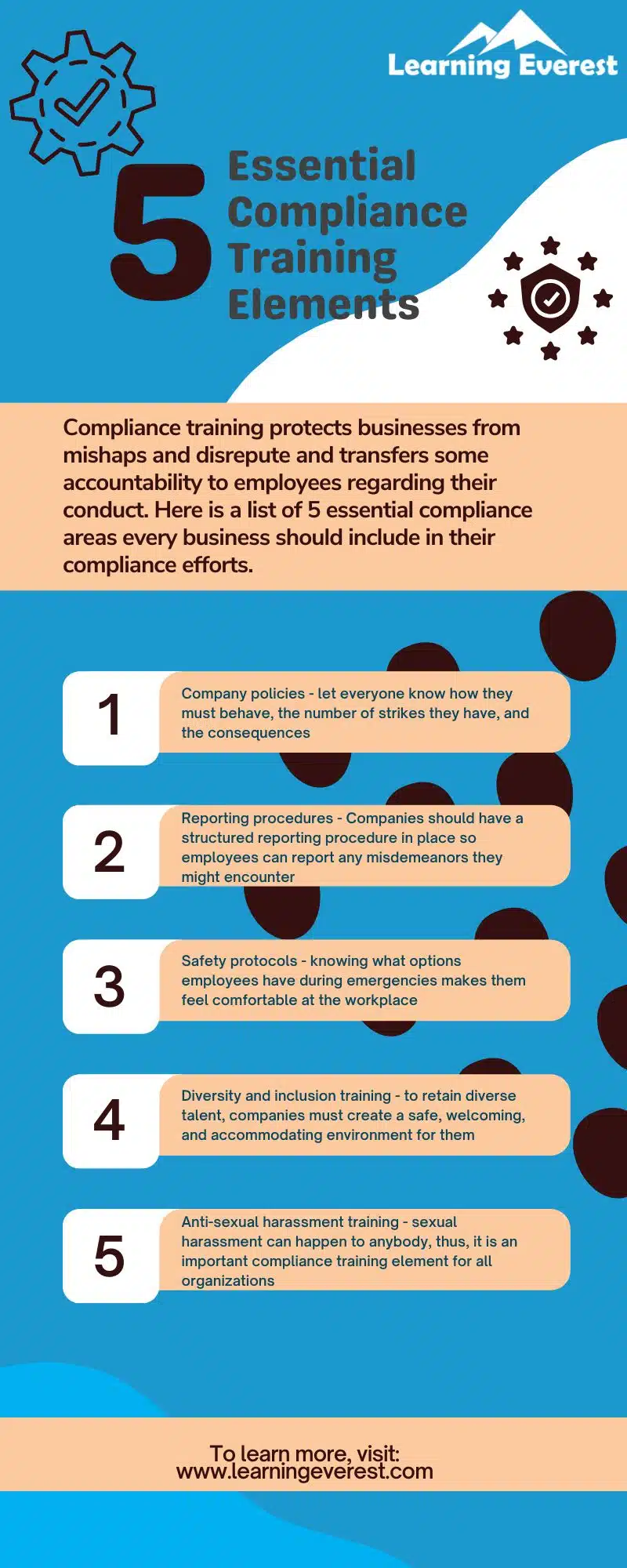Compliance training protects businesses from mishaps and disrepute and transfers some accountability to employees regarding their conduct. Different industries have different compliance requirements; however, some compliance training elements are essential for all modern organizations to function. Here is a list of 5 essential compliance areas every business should include in their compliance efforts. Continue reading to see if your business has all these bases covered.
1. Company Policies
The very first thing employees should be made aware of during compliance training is the company’s policies. Each company has its own code of conduct and behavior standards for employees and employers. These rules and policies also form a large part of the organizational culture. Company policies list down these responsibilities, stating what an employee is expected to do, what the employer is expected to do, and what happens if either party fails to uphold their end of each responsibility.
Some common company policy topics include conduct, leaves, attendance, bullying, dress code, harassment, etc.
Company policies are an essential compliance training element because they let everyone know how they must behave, the number of strikes they have for misconduct, and the consequences of repeated misconduct. They ensure that organizations run smoothly and that people have a professional and cordial environment to work in.
2. Reporting Procedures
This compliance training element perfectly complements the first one. Companies should have a structured reporting procedure in place so employees can report any misdemeanors they might encounter.
Reporting procedures let employees know that their grievances will be heard and acted upon. Reporting procedures should typically include whom employees should go to in the event of an incident, what are their backup options for people to contact, the protocol for reporting such as forms, emails, letters, etc., and what protections they will get if they want to report something.
3. Safety Protocols
Employees should also be given thorough workplace safety training so they can feel prepared for any unfortunate incidents. Unsafe environments can cost companies thousands in fines and losses and employees deserve a safe working environment, no matter what their job. For this reason, safety training is another essential and universal compliance training element.
Safety protocols typically cover topics such as natural disasters (for e.g., earthquakes), lab safety, fire safety, active shooting incidents, and other similar threats, and how to deal with violence in the workplace.
Knowing they have options if an event occurs makes employees feel more comfortable at the workplace.
4. Diversity and Inclusion Training
Diversity and inclusion have become an important generational value for millennials and Gen Z. At the same time, businesses have realized that diverse workforces have a larger capacity for creativity and innovation. Thus, modern workplaces are now becoming more open than ever to hiring diverse individuals and shed their past biases. However, minorities are still unsafe outside their communities even today.
Due to this, diversity and inclusion training is a vital compliance training element for modern organizations. To retain their diverse talent, they must create a safe, welcoming, and accommodating environment for them. And building this empathy among their existing workforce can only be achieved through targeted diversity and inclusion training.
Referring back to the first point, a company’s stance on diversity as well as the parameters and consequences for discriminatory behavior can be listed in the company policies.
5. Anti-Sexual Harassment Training
The prevalence of sexual harassment in workplaces is a hard pill to swallow for most of us. Environments where power structures and hierarchies are unavoidable unfortunately also make its abuse easier. Sexual harassment leaves a long-lasting impact on victims, is a criminal offense in many cases, and has serious consequences for an organization’s reputation.
Thus, businesses today proactively conduct anti-sexual harassment training to mitigate its adverse effects. While minorities have a much higher risk of being victims, sexual harassment can happen to anybody. Thus, it is a very important compliance training element for all organizations, regardless of their gender ratios.
E-Learning and Compliance Training
E-learning can make organizational compliance training efforts easier, engaging, quicker, and cost-efficient. E-learning offers many options that fit all budget brackets and learner groups. Some tools e-learning utilizes to deliver effective compliance training are:
- Microlearning – Compliance training is known for being dry and boring for learners. Microlearning helps solve this problem by offering easily consumable 10-minute modules that are quick, interactive, and to-the-point
- Use of Multimedia – Graphics, voiceovers, videos, and animations can make content more engaging for learners to consume. E-learning utilizes some or all of these elements to make compliance training modules interesting
- Gamification – Gamification adds narratives, relatability, and rewards to compliance training, making it more memorable for learners
Infographics

5 Essential Compliance Training Elements
Conclusion
Without compliance training, organizations put themselves and their employees at risk. Effective compliance training, on the other hand, creates safe and productive environments, which in turn attracts the best talent and good press. Out of the mentioned compliance training elements, are there any you found your organization is lacking or needs to improve on?





